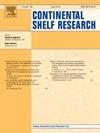南海西北部沿海海锋的垂直环流和热通量
IF 2.2
3区 地球科学
Q2 OCEANOGRAPHY
引用次数: 0
摘要
本文利用广义Omega方程对2018年8月下旬和9月初的巡航观测资料,研究了南海西北部沿海洋面的三维结构和垂直环流。结果显示在表层和次表层存在3个夏季密度锋区(SUF1 ~ 3)。SUF1沿海岸分布,水深小于20 m,密度梯度大于0.2 × 10−3 kg m−4。它由表面向底部垂直延伸,以盐度梯度为主。而SUF2和SUF3则是出现在近海次表层的以温度为主的锋面区。SUF2位于20米和40米等深线之间的交叉陆架方向,与来自南方的上升流有关。观测到的亚中尺度锋面的罗斯比数为0(1)。诊断的垂直速度表明,SUF1在海岸附近有一个4.2 × 10−5 m s−1的上升流峰,而跨陆架SUF2的最大垂直速度为−5.1 × 10−5 m s−1。动力分析结果表明,地转平流是主导项。由垂直速度和温度异常引起的垂直热通量在SUF1和SUF2均以正为主,最大值分别为279.5 W m−2和418.8 W m−2,比观测期间海面热通量大一个数量级。本文章由计算机程序翻译,如有差异,请以英文原文为准。
Vertical circulation and heat flux of coastal ocean fronts in the northwestern South China Sea
This study investigates the 3D structure and vertical circulation of the coastal ocean fronts in the northwestern South China Sea (NWSCS) by applying the generalized Omega equation to cruise observations in late August and early September 2018. The results reveal three summer density front zones (SUF1∼3) in the surface and subsurface layers. SUF1 is distributed along the coast with water depths shallower than 20 m and a density gradient larger than 0.2 × 10−3 kg m−4. It extends vertically from surface to bottom and is dominated by salinity gradient. In contrast, SUF2 and SUF3 are temperature-dominated frontal zones appearing in the offshore subsurface layer. SUF2 is in the cross-shelf direction between the 20-m and 40-m isobaths associated with upwelling waters originating from the south. The observed submesoscale fronts have a Rossby number of O(1). The diagnosed vertical velocities indicate that an upwelling peak of 4.2 × 10−5 m s−1 is located near the coast in SUF1, while, in contrast, a maximum vertical velocity of −5.1 × 10−5 m s−1 in the cross-shelf SUF2. Dynamic analysis results indicate that ageostrophic advection is the dominant term. The vertical heat fluxes derived from the vertical velocity and temperature anomaly are mainly positive both in SUF1 and SUF2, with a maximum value of 279.5 W m−2 and 418.8 W m−2, respectively, which are one order larger than the sea surface heat flux during the observation.
求助全文
通过发布文献求助,成功后即可免费获取论文全文。
去求助
来源期刊

Continental Shelf Research
地学-海洋学
CiteScore
4.30
自引率
4.30%
发文量
136
审稿时长
6.1 months
期刊介绍:
Continental Shelf Research publishes articles dealing with the biological, chemical, geological and physical oceanography of the shallow marine environment, from coastal and estuarine waters out to the shelf break. The continental shelf is a critical environment within the land-ocean continuum, and many processes, functions and problems in the continental shelf are driven by terrestrial inputs transported through the rivers and estuaries to the coastal and continental shelf areas. Manuscripts that deal with these topics must make a clear link to the continental shelf. Examples of research areas include:
Physical sedimentology and geomorphology
Geochemistry of the coastal ocean (inorganic and organic)
Marine environment and anthropogenic effects
Interaction of physical dynamics with natural and manmade shoreline features
Benthic, phytoplankton and zooplankton ecology
Coastal water and sediment quality, and ecosystem health
Benthic-pelagic coupling (physical and biogeochemical)
Interactions between physical dynamics (waves, currents, mixing, etc.) and biogeochemical cycles
Estuarine, coastal and shelf sea modelling and process studies.
 求助内容:
求助内容: 应助结果提醒方式:
应助结果提醒方式:


